Anything Can Happen in Life, Especially Nothing…
Interview with artist Michael Pybus
Solo show ‘Anything Can Happen in Life, Especially Nothing…’ at Tatjana Pieters, October 22 – December 10, 2017.
“As an artist learning to give yourself permission to make what you need to make opposed to what you think you should make is an extremely difficult lesson to learn but once it’s hardwired there’s no going back.” These are the words by British artist Michael Pybus, who we met for a talk about finding his own way of creating narratives without trying to blend in or please the establishment. He learned the lesson the hard way, but today holding back is simply not an option. Driven by his own voice, he explores the social structures of the Westernised consumer society, drawing on iconography from companies such as Pokémon and IKEA as it is the case in his current solo show ‘Anything Can Happen in Life, Especially Nothing…’ at Tatjana Pieters in Ghent, Belgium. Despite its layers of color and playfulness, Michael Pybus’ artistic universe confronts some of the darker realities lurking under the surface of the latest selfie. The floodgates are open. Now, anything can happen…
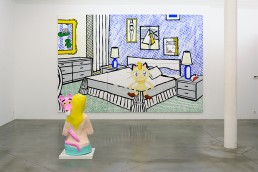
Anything can happen in life, how did you end up being an artist?
I don’t think I ended up an artist, more so I followed my gut and pursued the development of my creative drive, which eventually led me to a position in society where my work is exhibited and collected which I suppose classes me an ‘artist’ to a wider consensus, but in reality, looking back, I have felt I was an artist for as long as I can remember, I just didn’t have the correct vocabulary or experience to understand that.
In the environment I grew up in, no one really knew what to do with me, this was the pre-internet mid-90s rural countryside of Northern England. The only reference anyone had to artists were of dead ones in books. The idea someone could be a living artist and have that as a career in the present was an alien concept. I was always told I should be an architect or interior designer, you know something ‘practical’, but that was never going to work for me.
It was by chance one day I caught a programme on TV about the Turner Prize and happened to tune in on a segment featuring Tracey Emin. Her tenacity really struck a chord with me and this was around the same time Damien Hirst was getting a lot of press coverage for his work in the tabloids. They both helped me realise that you can make a life out of being an artist, and a very good life at that. Both Emin and Hirst were from poor working class backgrounds like my own and were now top of their game. To see that they had managed to enter a cultural sphere that historically had not been very accommodating of people like them/me was really inspirational. They didn’t try to blend in or please the establishment they wrote their own script, creating new vocabulary and narratives to express what and how they needed to. From that moment on, I was sure this was the path I would focus on.

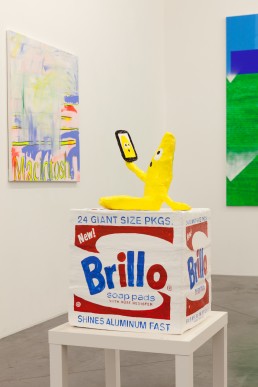
For your new exhibition ‘Anything Can Happen in Life, Especially Nothing…’ at Tatjana Pieters, you have transformed the gallery into a kind of museum theme park, where every work is sampled from the art historical canon and then reconfigured in new ways. Which story do you seek to tell in the show?
We’re at a funny moment in culture where we are all encouraged to broadcast our lives to anyone and everyone, regardless of whether we have something to say or not. Living in a Westernised consumer society that constantly indulges our egos, pushing us to express our individuality through mass produced goods and ideas has created a paradox where we all kinda end up the same. This open arena has birthed a herd mentality, a hive mind outlook. The idea of the ‘artist’ in our collective consciousness is that of the rule breaker, the pinnacle of individual expression – the true original. I find that kinda funny, artists are just people like anyone else and any pursuit of originality I find is just futile and pointless.
Since the launch of the iPhone and increasing coverage of internet service, I’ve witnessed a flattening out of context, time, hierarchy and access in culture which now exists on a seemingly infinite plane to which we can load, reload, remix, post, delete and edit at will. It is such an unusual situation to find ourselves in especially for those of us like me who grew up in an analogue era of very organised and limited access to information and connectivity.
With all this in mind for my show at Tatjana Pieters I wanted to explore what an identity is in the age of Instagram. Every work in the show is sampled from another much more famous and well known artist to which I would then reconfigure as one would when playing about with Snapchat filters or creating a new meme on Photoshop. I am trying on the identities of others as an act of self expression. The result is a series of paintings, drawings and sculptures that mock the cult of the individual.
In the exhibition, the past and the present are intertwined with references to celebrated artists and consumerist iconography such as IKEA and Pokémon side by side. Is this the total collapse of the hierarchy of culture or a restoring of just that?
It just is what it is. I wasn’t raised in a cultural environment where I understood the difference between high and low, mainly because all I had access to was what society would call ‘low’ or ‘pop’ – films, TV, magazines, computer games and music. The power of these mediums is not to be underestimated, they opened up such a huge universe of possibilities and ideas to me. I could see how other people from far away spoke, expressed, dressed and lived, I couldn’t get enough of it. I know that sounds quaint by today’s standards where we have the whole world literally in the palm of our hands. As I grew older and moved to London to study art, I learnt more about ‘high’ culture, however for me there was never really any internal hierarchy. What speaks to me speaks to me, I don’t need to place value judgments on what is serious and what is frivolous. If something is useful, I use it!
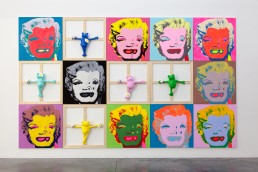
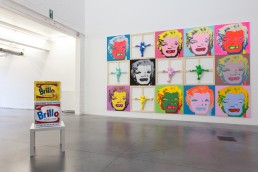
What is your own relationship to and/or history with IKEA and Pokémon, did any particular experiences motivate you to make them the protagonists of your artistic universe? And how are they a driver of your creativity?
I had been making work continuously for 14 years and yet had no real success in a professional sense. About 4 or so years ago I reached a breaking point where I said to myself ‘you know what, no one is paying any attention to you so fuck it and make whatever the fuck you want to.’
In hindsight I can see that up to that point I had been holding back, making and presenting my work in ways in which I thought was the ‘right’ way a serious artist would do something, I had all these subconscious hang ups of what are valid and not valid modes of expression. Then something in my head just snapped and the floodgates opened.
I began excessively working with the source materials and ideas that have always interested me not just on an intellectual level but also on a visual level and a consumer level. As an artist learning to give yourself permission to make what you need to make opposed to what you think you should make is an extremely difficult lesson to learn but once it’s hardwired there’s no going back.
You ask about IKEA and Pokémon in particular, I’ll begin with IKEA. As I mentioned earlier I grew up in a pre-internet rural environment, anything new, modern or different was almost impossible to come by. The IKEA catalogue was free and packed with page after page of colourful, modern designs that looked like something from another planet to me. I would constantly leaf through it imaging the furniture I would buy if I had the money and my own home. The catalogue was a visual lesson in possibility for me, the companies approach to design and engineering encouraged me to offer people a point of view, a product they may not even realise they want until it is placed in front of them. It felt natural for me to begin using the brand and its products in my own work, it’s global, it’s viral in the sense that just about everyone has some of their products in their homes and its bold graphic aesthetic spoke to my own visual sensibilities.
The global viral nature of Pokémon again is part of what attracts me to working with it. The franchise is a masterclass in marketing, with Nintendo inventing a world and a group of cute little characters the player has to ‘catchemall!’ however the only way to do it is to have both versions of the game and then each subsequent release of the game adds even more Pokémon to catch and requires you to obtain both versions to collect them all again. It’s this amazing Trojan Horse storyline of hyper consumption and obsessive accumulation cloaked in bright cute colourful packaging. A narrative which mirrors a greater global conversation of how we are manipulated and encouraged to excessively consume today.
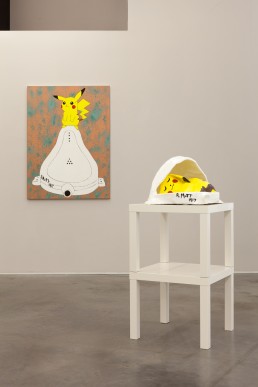
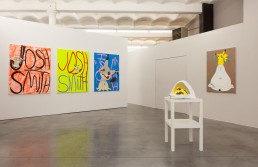
Which role do artists like Koons, Lichtenstein, Warhol and Picasso play in our collective consciousness today? Do you think that they are viewed as the icons of high culture?
All four artists are pretty much cemented in history, I think it would be difficult to argue from our Western perspective that they are anything other than examples of high culture. As with most people and things that find themselves part of our collective consciousness their roles are malleable in the sense that anyone can project whatever they need to onto them. In general terms those four artists represent success, extreme wealth and desirability. Their works are readily used as currency both economically and as status in ‘high’ society and pop culture at large.
With the use of familiar imagery of consumer brands, the exhibition is rooted in the present social context, mirroring the dominant cultural values. It seems to be both a product of our consumer society and a critique of it, a capitalist nightmare and a utopia all at once. Where do you see yourself in this cycle of life?
Right smack in the centre of it like everyone else in the Developed World, getting access to all the amazing and convenient products our globally industrialised production grants us – healthcare, entertainment, food, travel, technology and a standard of living so ridiculously high compared to most of human history both past and present. I’m also totally aware this comes at a cost, that being the extreme destruction of the natural environment and a much poorer living standard for those born into Developing countries. It’s insane, we flush our toilets with 100% pure drinking water while millions of people around the world are forced to drink from contaminated supplies. One of the reasons The Hunger Games novels and subsequent films caught my attention was that they deeply explored this scenario of extreme imbalance. As the audience we are to think the frivolous wealthy Capitol citizens in the story are disgusting, spoilt and over indulgent with their heavy consumer demands at the detriment to the many, but the reality is that they are us. I struggle with this as I am a benefactor of the current global system, it has overwhelmingly been a force of good for me but through my work I hope to in some way highlight and dissect some of the darker realities that provide the scaffolding to our brave new world.
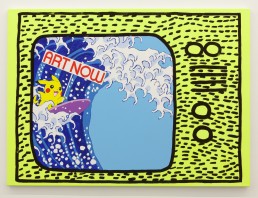
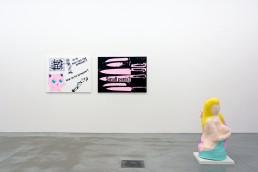
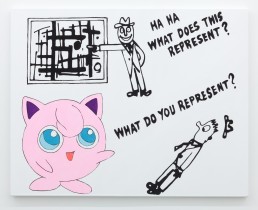
What is your opinion of the role of the collector in the consumer society of today?
Within the consumer society as a whole, well, they are just another consumer. Their role within the commercial art world is much more interesting to me, without them there would basically be no commercial art world. There’d still be artists and galleries but nothing on the scale that we have today. They are the lifeblood to the system, without them artists and gallerists would be wholly reliant on public funding and grants and all the box ticking bullshit and jumping through hoops that goes along with it.
For many many years there was practically zero interest in my work. The moment my work started being collected was the moment my life improved hugely. The money allowed me to be fully self sufficient, everything I earned I put back into my work. I went from scraping together cash to buy cheap paint and canvases from the 99p store to being able to buy quality materials and start painting more and bigger. This allowed for my work to develop exponentially, which lead to more interest in my work, more exhibitions and most importantly a great leap of development in my practice. From my own personal experience, I cannot overestimate the importance of collectors especially those who are willing to take a leap of faith, follow their gut and invest their money in purchasing works by artists who aren’t yet household names in the art world.
‘Anything can happen in life, especially nothing’. Can you elaborate a bit on the exhibition title?
It is a quote from one of my favourite novels ‘Platform’ written by Michel Houellebecq – I love how the sentence seems to be leading you to somewhere positive, then falls flat and cancels itself out. I felt this was a fitting title for an exhibition of works which are facsimiles of other people’s works. I’m in a way cancelling out my identity as an artist or at the very least filtering it through someone else’s identity which may appear counterproductive to a creative act. The title also reminds me of Work No.232 by Martin Creed which reads ‘the whole world + the work = the whole world’ – again a statement which cancels itself out. Removing the romantic ideals of uniqueness or originality that are often applied to creative acts when judging if they are worthy or not.
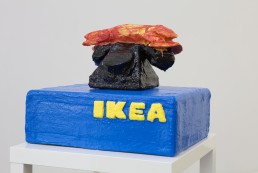
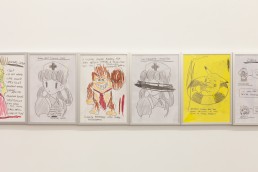
The term ‘nothing’ has a negative ring to it… or what? In today’s world, where we are expected to be online all the time, constantly in the process of adding filters to yet another selfie and tagging whoever is nearby in a new post on Instagram, doing nothing seem like an utopian state of mind. Do you ever do nothing?
If I’m lucky, I’m going to get around 80 years of consciousness and then that’s it for infinity. I am a citizen of one of the richest countries in the world, I have free health care, I had access to great education and am alive to enjoy all the benefits of the most technologically advanced civilisation that has ever existed, doing nothing is not even a remote possibility for me.
Life is full of distractions and you can make as many excuses as you wish but the reality for most people is that if you want to achieve something you have to work insanely hard to the point of obsession to achieve success. I think one of the most important approaches to achieving your goals is not seeking the validation of others, which I know sounds like an oxymoron but it’s about staying true to your point of view, building an industry around your voice. In the beginning, this can be a lonely place to be especially if what you have to say isn’t on trend, but over time with enough energy and development, people do eventually start coming round to you, and by that point you are in a much stronger position to handle the demands of an art career than if you just tried to play to the audience and give them what you think they want.
Speaking of titles. Your exhibition titles carry a lot of literary and visual playfulness such as the one above or ‘hubcaP sMiley. Feat F ·R ·I ·E ·N ·D ·S ✓Friends’ and ‘WEAK END’. How do your use of words supports your artistic universe?
The words are collaged points of reference like everything else I use whether that be visual information or literary information. Words in particular are useful when titling an exhibition as they can help guide the audience in a particular direction when looking at the visual works in the show that are often more coded and abstracted in appearance.
What would be your title of the current state of the art world?
Business as usual.
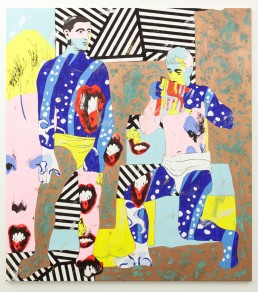
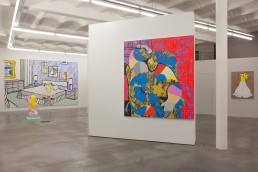
About Michael Pybus
Lives and works in London, UK
Instagram: @michaelpybus
Education
2006 – 08: Sculpture MA Royal College of Art, London UK
2001 – 04: Fine Art BA (Hons) Goldsmiths College, London UK
Solo shows
Forthcoming Jelato Love, Palma, Majorca Spain
2017
Anything can happen in life, especially nothing… Tatjana Pieters Ghent, BE 22 Oct – 10 Dec
HOLLOW Thierry Goldberg NYC, USA
Pretend the world is funny and forever – Amor, Mexico City, MX
PEAK HUMAN – Depart Foundation LA, USA *A Hollywood Garden – The Cabin LA, USA
HIVE MIND – Jonathan Hopson Gallery Houston, USA
2016
CRUMPLE ZONE – Tatjana Pieters, Gnent BE Karaoke – Carl Kostyal Stockholm, SWEDEN
Nowhere – Savingy Hotel Frankfurt, DE
2015
IF IT WORKS, IT’S OBSOLETE – Johannes Vogt NYC, USA
hubcaP sMiley feat F ·R ·I ·E ·N ·D ·S ✓Friends – Evelyn Yard London, UK OUTDOOR SCULPTURE – Sol’s Back Yard, Bushwick, NYC, USA
2014
In 3D the basil never wilts – Simon Oldfield Gallery HAPPY TIME Grovenor art comission, London UK
2013
WEAK END ohmydays, Singapore
QUICKSAND – Artereal Project Space, Sydney Australia
2012
WHITE GOODS – Schwartz Gallery Project Space, London UK
2011
just doing something – ANDOR, London UK
Selected group shows
2017
Summer Hang Tatjana Pieters Gent, BE Flowers – Plus One Antwerp, BE
In 3D the basil never wilts REMIX – Castor NYC, USA
Group show David B Smith Gallery Denver, USA Searching for magic and the distorted image falling from your iCloud – The Dot Project / London, UK
2016
Finally – Castor Gallery NY, USA
Thirsty Garten – The Composing Rooms, Berlin DE
The Names – Transition Gallery London, UK
2015
People You May Know curated by Debora Delmar – Bosse + Baum London
I refuse to participate in failure – Spreez Munich, Germany Business as Usual curated by Perce Jerrom – Turf Projects, London
Drops of Jupiter – Bannerette NYC, USA
Dimensions Variable – 84 Hatton Gardens London, UK
Business as usual – STCFTHOTS Leeds, UK
2014
The Drawer Col 7 The Drawer Paris, France
BOND STREET BAR – Max Wigram Gallery, London
UK BASIC BITCHES – Skylab, Columbus USA
EVENT HORIZON curated by Gino Saccone – Galerie Gabriel Rolt, Amsterdam Netheralnds
Zinger Humdinger – Canal, London UK
Imagine FOREVER – Proust Project 3 at Gloria Maria Gallery (online) The Honeymoon Suite – ‘Michael Pybus KNOCK OFF SHOP feat Keith Allyn Spencer’ Simon Oldfield Gallery, London UK
#Artistsbelike – Nurtureart, Brooklyn USA
Ride the Judd Act II – Hardy Tree Gallery, London UK Ride the Judd Act I – Hardy Tree Gallery, London UK
Hangwoman – Schwartz Gallery, London UK
2013
CLICK + SPILL Artemis House Project Space, York UK
Apartment 4 – Clermont-ferrand France THIS IS NOT ABOUT YOU/I DID NOT CHOOSE TO BE HERE (Schopenhauer recalls the abrupt moment his mother was fertilized)- Oliver Francis Gallery, Dallas USA
2012
Angelika Open – Angelika Studios, High Wycombe UK
More information
michaelpybus.com
tatjanapieters.com
Get your free copy of Artland Magazine
More than 60 pages interviews with insightful collectors.